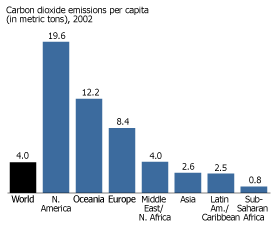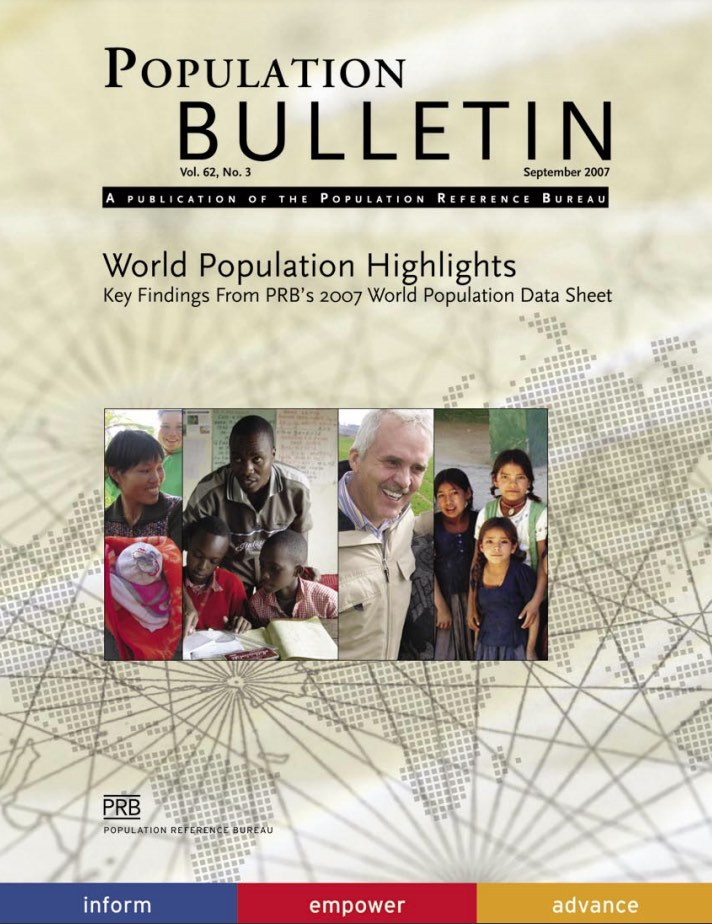
World Population Highlights 2007: Environment
Date
August 16, 2007
Author
(September 2007) Carbon dioxide emissions have grown dramatically in the past century because of human activity, chiefly the use of fossil fuels such as oil and coal, as well as changes in land use such as cutting down forests. These emissions are a key contributor to climate change that is expected to produce rising temperatures, lead to more extreme weather patterns, facilitate the spread of infectious diseases, and put more stress on the environment.
The United States is the largest contributor of total carbon dioxide emissions, and has one of the highest per capita rates. The U.S. per capita emission rate has risen from 19.2 metric tons per person to 19.9 metric tons between 1990 and 2002, according to the World Resources Institute.
Per capita use also has gone up in China, rising from 2.2 to 2.9 metric tons between 1990 and 2002. China is expected to surpass the United States in total carbon dioxide emissions by 2009.
Protected Natural Habitat
Data from the Nature Conservancy show that the countries with the largest amounts of land unconverted to human use include desert nations such as Saudi Arabia and Oman. At the other end of the spectrum, virtually no undeveloped land is left in small urbanized nations such as Monaco and Singapore.
The Nature Conservancy numbers account for land converted to agricultural use, cities and towns, and roads and railroads. One caveat: Unconverted land is not necessarily untouched; some has been stripped of its natural fauna and/or altered by grazing cattle.
A Large Gap Exisits Betweeen Carbon Dioxide Emissions of Developed and Developing Regions

Source: Carl Haub, 2007 World Population Data Sheet.
Case In Point.
Forests play a key role in capturing carbon dioxide emissions, in addition to supplying vital habitat and retarding soil erosion. When forests are cut down or burned, carbon dioxide is released that contributes to global warming. More than half the net decline in world forest acreage between 2000 and 2005 was in South America, according to figures from the UN Food and Agriculture Organization.
The decline of Brazil’s forest cover, from 493 million hectares to 478 million hectares, was the largest contributor. But new conservation efforts in Brazil are raising hopes that the rate of loss has been curbed. Deforestation in Amazonia has been reduced from 2.6 million hectares in 2004 to 1.9 million hectares in 2005, and a preliminary figure of 1.3 million hectares in 2006, according to figures cited by the UN Environment Programme.
Sources
Food and Agriculture Organization of the United Nations, State of the World’s Forests 2007, accessed online at www.fao.org, on July 9, 2007.
Carl Haub, 2007 World Population Data Sheet (Washington, DC: Population Reference Bureau, 2007).
Michael D. Jennings, Gross Amount of Habitat Lost by Country (Moscow, Idaho: The Nature Conservancy, 2007).
United Nations Environment Programme, GEO-2000 Global Environmental Outlook, accessed online at www.unep.org, on July 9, 2007.
World Resources Institute, CO2 Emissions per Capita, accessed online at http://earthtrends.wri.org, on July 9, 2007.

 ">
">